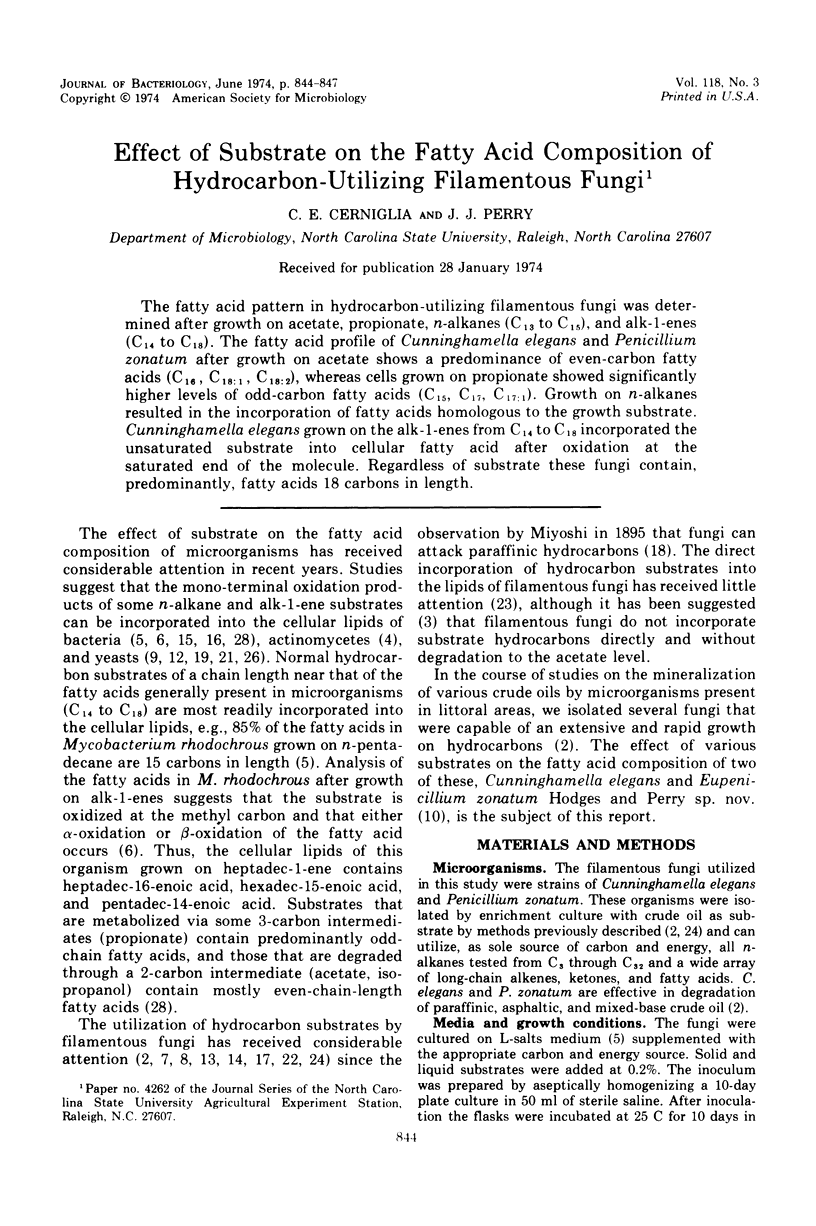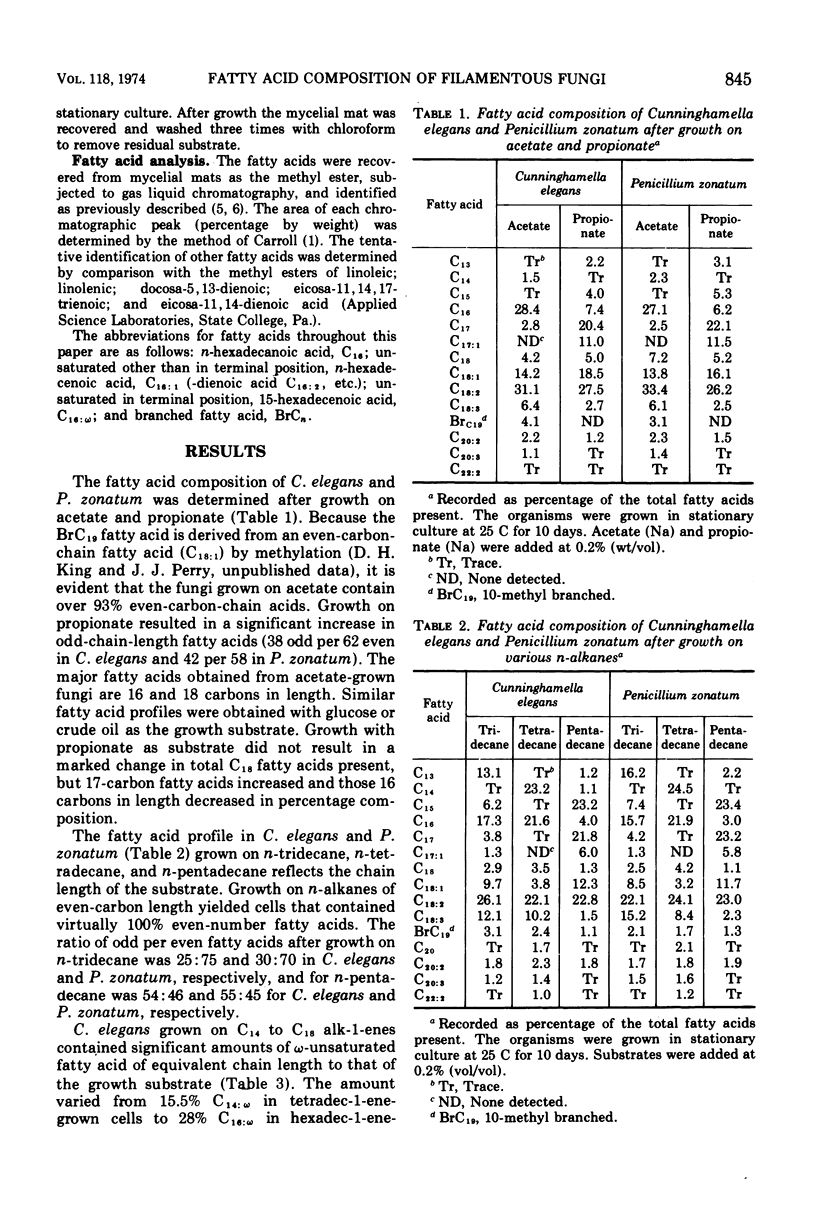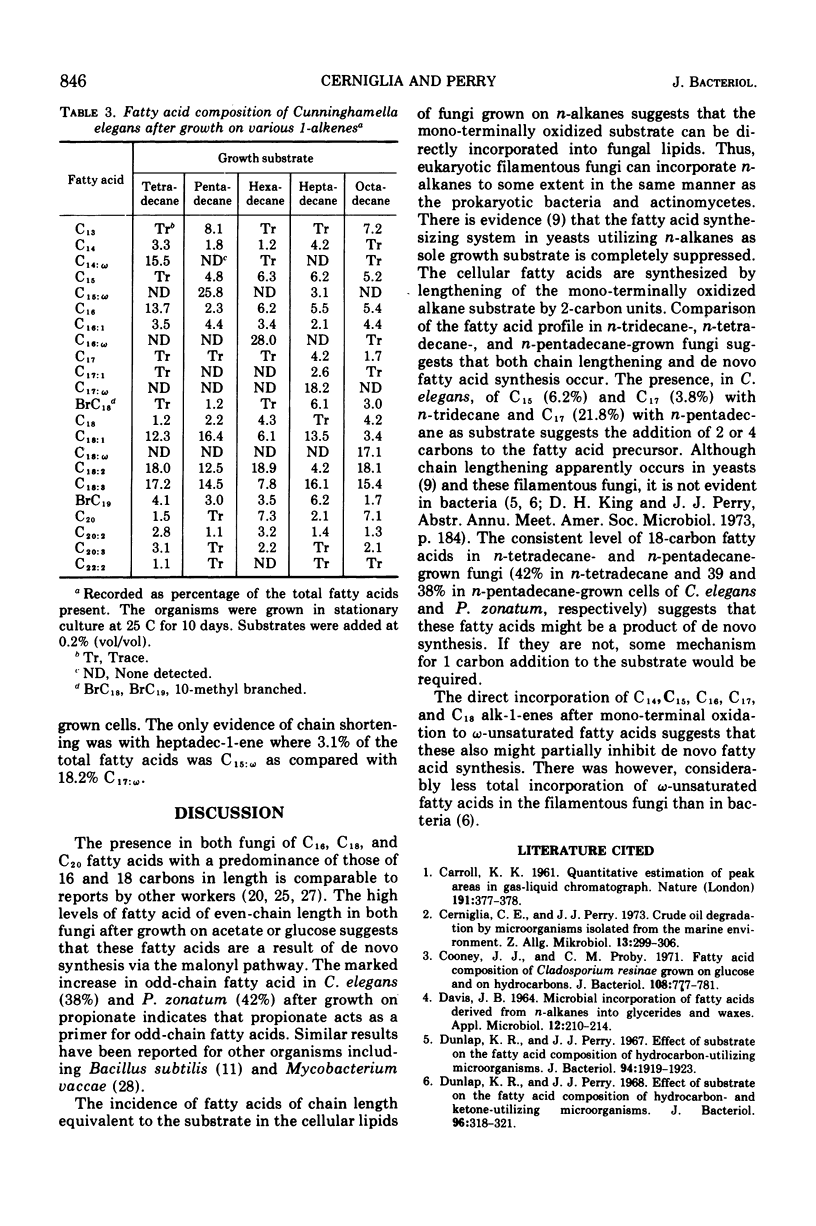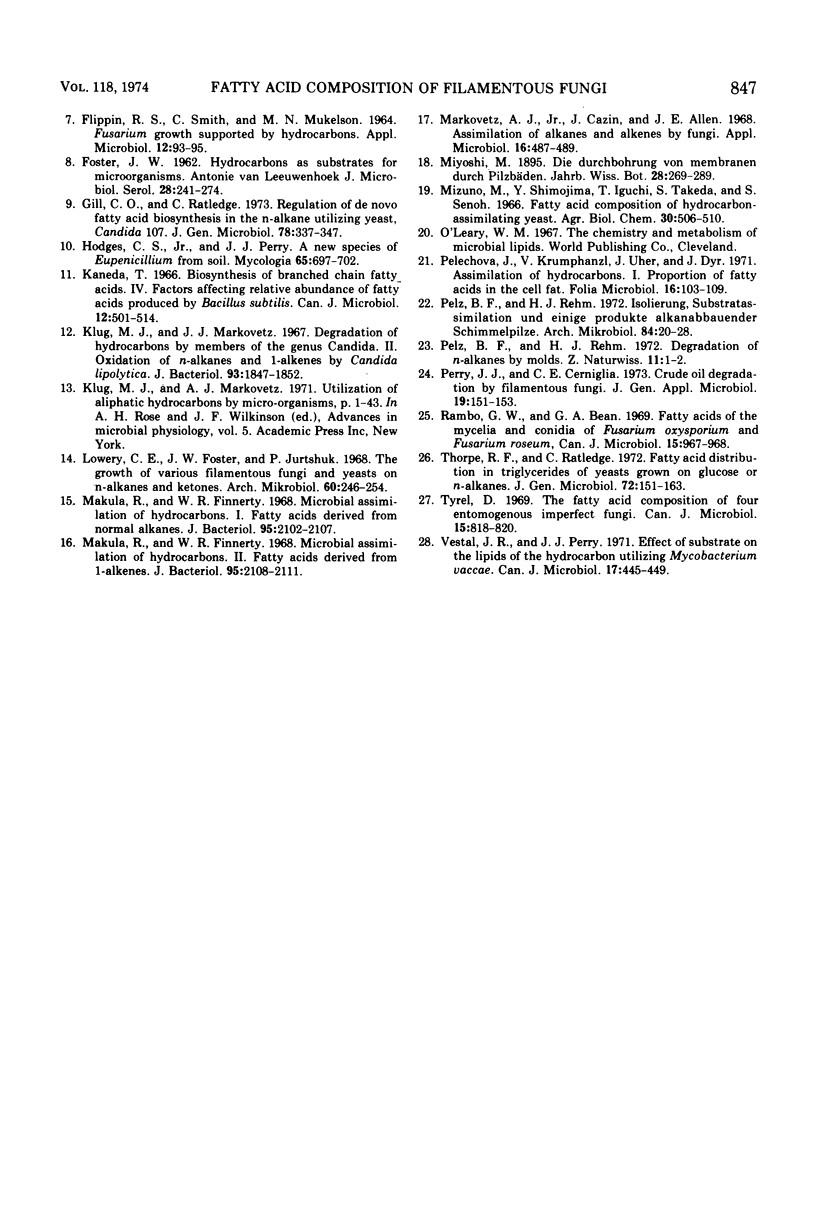Abstract
The fatty acid pattern in hydrocarbon-utilizing filamentous fungi was determined after growth on acetate, propionate, n-alkanes (C13 to C15), and alk-1-enes (C14 to C18). The fatty acid profile of Cunninghamella elegans and Penicillium zonatum after growth on acetate shows a predominance of even-carbon fatty acids (C16, C18:1, C18:2), whereas cells grown on propionate showed significantly higher levels of odd-carbon fatty acids (C15, C17, C17:1). Growth on n-alkanes resulted in the incorporation of fatty acids homologous to the growth substrate. Cunninghamella elegans grown on the alk-1-enes from C14 to C18 incorporated the unsaturated substrate into cellular fatty acid after oxidation at the saturated end of the molecule. Regardless of substrate these fungi contain, predominantly, fatty acids 18 carbons in length.
Full text
PDF



Selected References
These references are in PubMed. This may not be the complete list of references from this article.
- CARROLL K. K. Quantitative estimation of peak areas in gas-liquid chromatography. Nature. 1961 Jul 22;191:377–378. doi: 10.1038/191377a0. [DOI] [PubMed] [Google Scholar]
- Cerniglia C. E., Perry J. J. Crude oil degradation by microorganisms isolated from the marine environment. Z Allg Mikrobiol. 1973;13(4):299–306. doi: 10.1002/jobm.3630130403. [DOI] [PubMed] [Google Scholar]
- Cooney J. J., Proby C. M. Fatty acid composition of Cladosporium resinae grown on glucose and on hydrocarbons. J Bacteriol. 1971 Nov;108(2):777–781. doi: 10.1128/jb.108.2.777-781.1971. [DOI] [PMC free article] [PubMed] [Google Scholar]
- DAVIS J. B. MICROBIAL INCORPORATION OF FATTY ACIDS DERIVED FROM N-ALKANES INTO GLYCERIDES AND WAXES. Appl Microbiol. 1964 May;12:210–214. doi: 10.1128/am.12.3.210-214.1964. [DOI] [PMC free article] [PubMed] [Google Scholar]
- Dunlap K. R., Perry J. J. Effect of Substrate on the Fatty Acid Composition of Hydrocarbon- and Ketone-utilizing Microorganisms. J Bacteriol. 1968 Aug;96(2):318–321. doi: 10.1128/jb.96.2.318-321.1968. [DOI] [PMC free article] [PubMed] [Google Scholar]
- Dunlap K. R., Perry J. J. Effect of substrate on the fatty acid composition of hydrocabon-utilizing microorganisms. J Bacteriol. 1967 Dec;94(6):1919–1923. doi: 10.1128/jb.94.6.1919-1923.1967. [DOI] [PMC free article] [PubMed] [Google Scholar]
- FLIPPIN R. S., SMITH C., MICKELSON M. N. FUSARIUM GROWTH SUPPORTED BY HYDROCARBONS. Appl Microbiol. 1964 Mar;12:93–95. doi: 10.1128/am.12.2.93-95.1964. [DOI] [PMC free article] [PubMed] [Google Scholar]
- FOSTER J. W. Hydrocarbons as substrates for microorganisms. Antonie Van Leeuwenhoek. 1962;28:241–274. doi: 10.1007/BF02538739. [DOI] [PubMed] [Google Scholar]
- Gill C. O., Ratledge C. Regulation of de novo fatty acid biosynthesis in the n-alkane-utilizing yeast, Candida 107. J Gen Microbiol. 1973 Oct;78(2):337–347. doi: 10.1099/00221287-78-2-337. [DOI] [PubMed] [Google Scholar]
- Kaneda T. Biosynthesis of branched-chain fatty acids. IV. Factors affecting relative abundance of fatty acids produced by Bacillus subtilis. Can J Microbiol. 1966 Jun;12(3):501–514. doi: 10.1139/m66-073. [DOI] [PubMed] [Google Scholar]
- Klug M. J., Markovetz A. J. Degradation of hydrocarbons by members of the genus Candida. II. Oxidation of n-alkanes and l-alkenes by Candida lipolytica. J Bacteriol. 1967 Jun;93(6):1847–1852. doi: 10.1128/jb.93.6.1847-1852.1967. [DOI] [PMC free article] [PubMed] [Google Scholar]
- Klug M. J., Markovetz A. J. Utilization of aliphatic hydrocarbons by micro-organisms. Adv Microb Physiol. 1971;5:1–43. doi: 10.1016/s0065-2911(08)60404-x. [DOI] [PubMed] [Google Scholar]
- Lowery C. E., Jr, Foster J. W., Jurtshuk P. The growth of various filamentous fungi and yeasts on n-alkanes and ketones. I. Studies on substrate specificity. Arch Mikrobiol. 1968;60(3):246–254. doi: 10.1007/BF00413491. [DOI] [PubMed] [Google Scholar]
- Makula R., Finnerty W. R. Microbial assimilation of hydrocarbons. I. Fatty acids derived from normal alkanes. J Bacteriol. 1968 Jun;95(6):2102–2107. doi: 10.1128/jb.95.6.2102-2107.1968. [DOI] [PMC free article] [PubMed] [Google Scholar]
- Makula R., Finnerty W. R. Microbial assimilation of hydrocarbons. II. Fatty acids derived from 1-alkenes. J Bacteriol. 1968 Jun;95(6):2108–2111. doi: 10.1128/jb.95.6.2108-2111.1968. [DOI] [PMC free article] [PubMed] [Google Scholar]
- Markovetz A. J., Jr, Cazin J., Allen J. E. Assimilation of alkanes and alkenes by fungi. Appl Microbiol. 1968 Mar;16(3):487–489. doi: 10.1128/am.16.3.487-489.1968. [DOI] [PMC free article] [PubMed] [Google Scholar]
- Pelechová J., Krumphanzl V., Uher J., Dyr J. Assimilation of hydrocarbons. I. Proportion of fatty acids in the cell fat. Folia Microbiol (Praha) 1971;16(2):103–109. doi: 10.1007/BF02887479. [DOI] [PubMed] [Google Scholar]
- Pelz B. F., Rehm H. J. Isolierung, Substratassimilation und einige Produkete alkanabbauender Schimmelpilze. Arch Mikrobiol. 1972;84(1):20–28. [PubMed] [Google Scholar]
- Rambo G. W., Bean G. A. Fatty acids of the mycelia and conidia of Fusarium oxysporum and Fusarium roseum. Can J Microbiol. 1969 Aug;15(8):967–968. doi: 10.1139/m69-171. [DOI] [PubMed] [Google Scholar]
- Tyrrell D. The fatty acid composition of four entomogenous imperfect fungi. Can J Microbiol. 1969 Jul;15(7):818–820. doi: 10.1139/m69-145. [DOI] [PubMed] [Google Scholar]
- Vestal J. R., Perry J. J. Effect of substrate on the lipids of the hydrocarbon-utilizing Mycobacterium vaccae. Can J Microbiol. 1971 Apr;17(4):445–449. doi: 10.1139/m71-075. [DOI] [PubMed] [Google Scholar]


